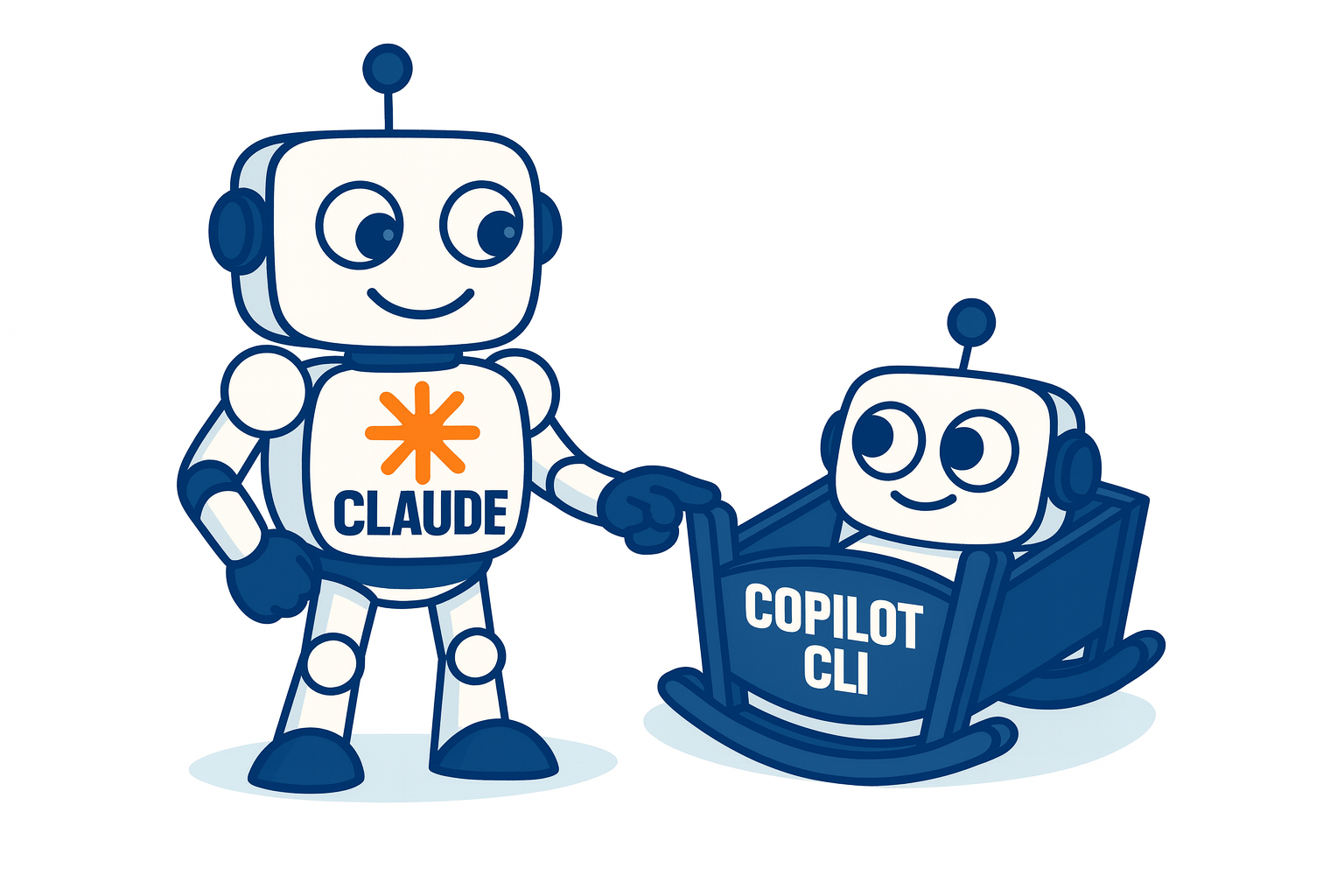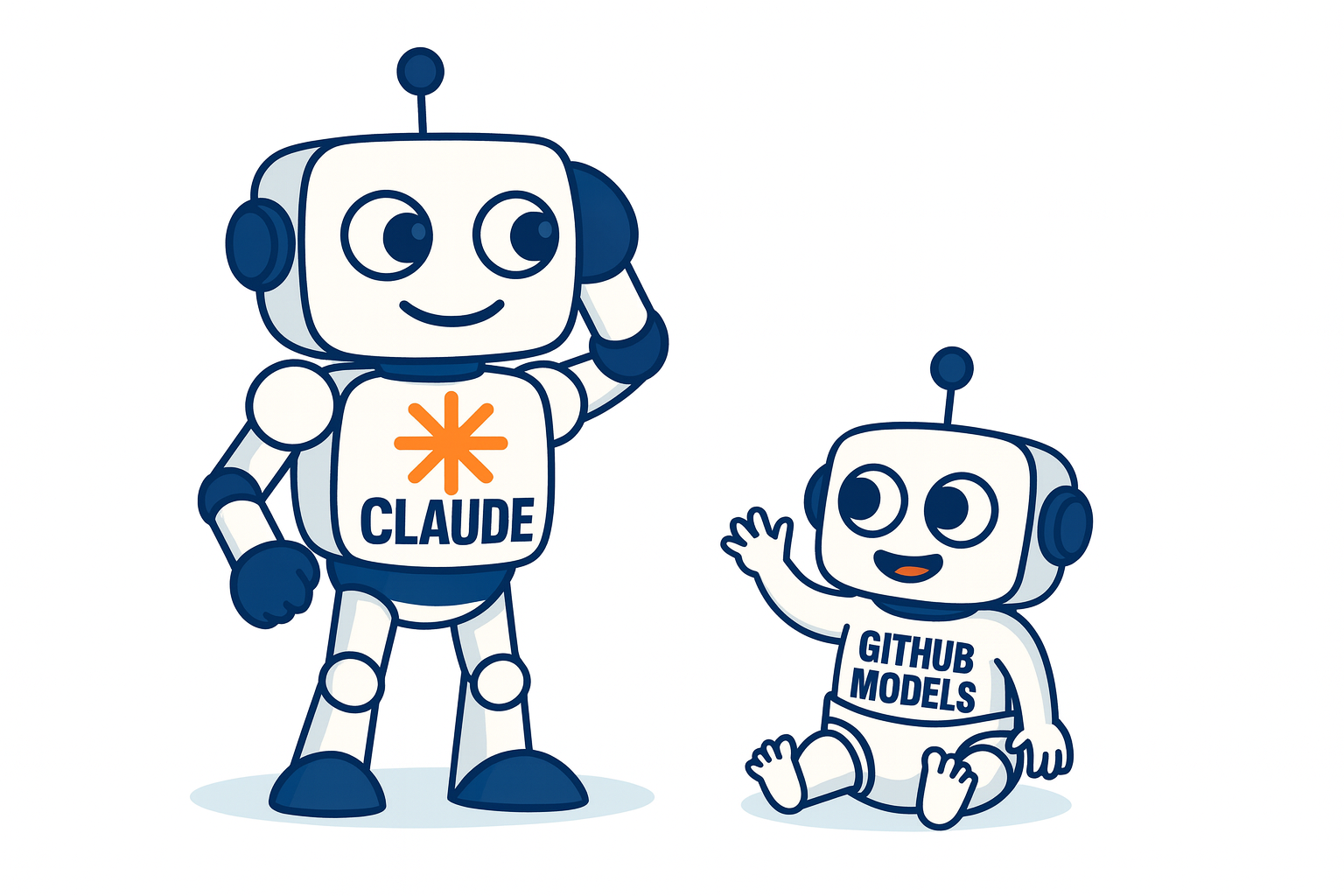Automating Code Reviews with Claude Code GitHub Actions

The evolution of AI-powered development tools continues to accelerate, and now we can bring the power of Claude Code directly into our GitHub workflows. With Claude Code GitHub Actions, you can have an intelligent AI assistant that automatically reviews pull requests, implements features from issues, and helps maintain code quality—all triggered with a simple @claude mention.
In this comprehensive guide, I’ll walk you through setting up Claude Code GitHub Actions from scratch, covering both the quick start method and enterprise-level configurations for AWS Bedrock and Google Vertex AI.
🚀 What is Claude Code GitHub Actions?
Claude Code GitHub Actions brings AI-powered automation to your GitHub workflow. Think of it as having a senior developer on your team who:
- ✅ Analyzes code and provides intelligent feedback
- ✅ Creates pull requests from issue descriptions
- ✅ Implements features following your coding standards
- ✅ Fixes bugs automatically with appropriate tests
- ✅ Follows your guidelines defined in
CLAUDE.mdfiles - ✅ Integrates seamlessly with your existing GitHub workflow
The beauty of this approach is that Claude runs on GitHub’s infrastructure, keeping your code secure while providing enterprise-grade automation capabilities.
🛠️ Prerequisites
Before we begin, make sure you have:
- Repository admin access (required for installing GitHub apps and managing secrets)
- Active Claude Code billing (via Anthropic Console, Claude Pro/Max, or enterprise cloud providers)
- Basic understanding of GitHub Actions and YAML workflows
📋 Quick Setup Method
The fastest way to get started is through Claude Code’s built-in installer. Let’s walk through this process step by step:
Step 1: Access GitHub Installation
First, navigate to GitHub and access the installation interface:
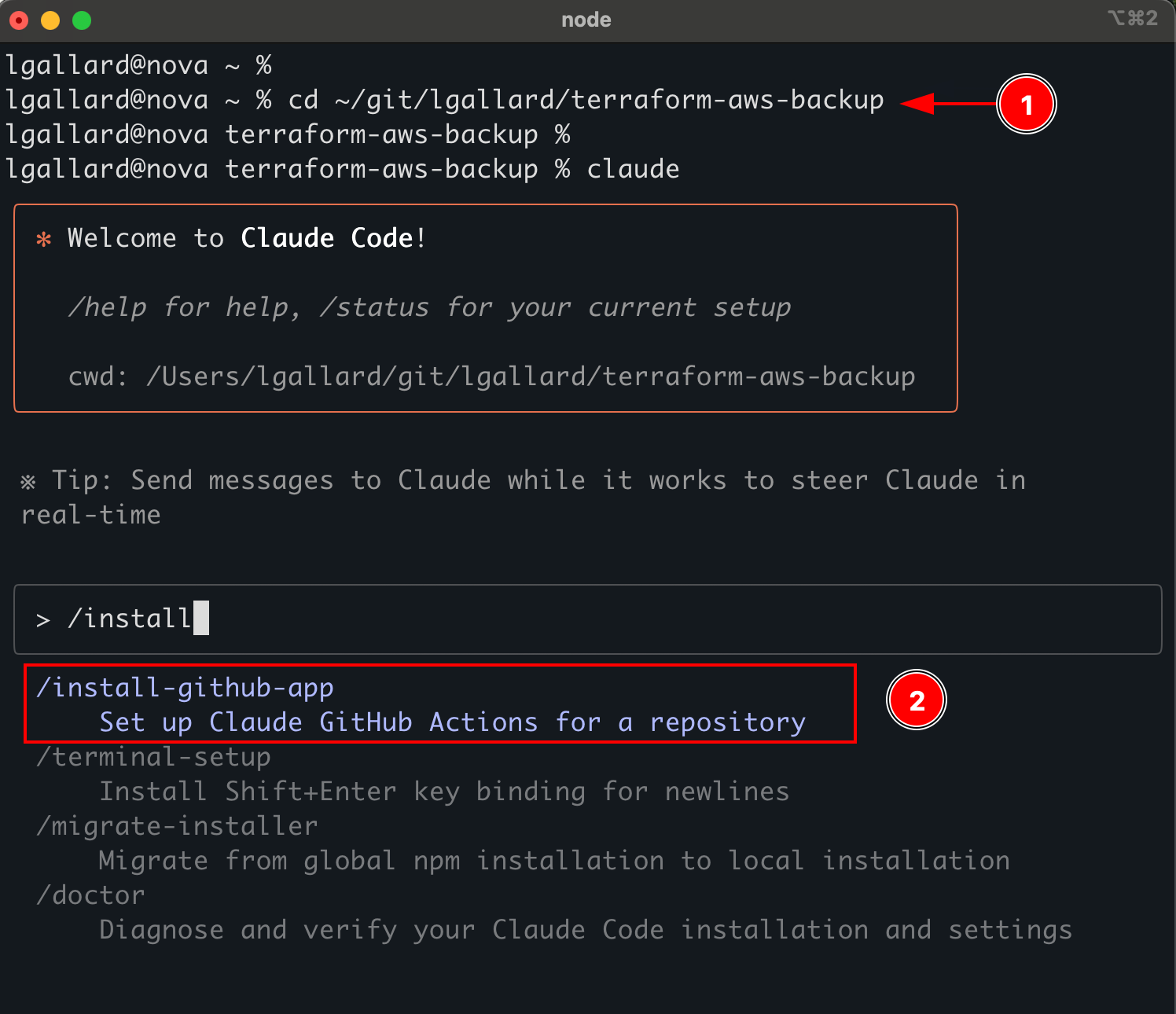
Open your terminal in your repository directory and run:
cd your-repository
claude
Then execute the installation command:
/install-github-app
Step 2: Select Your Repository
The installer will ask you to select which repository to configure:
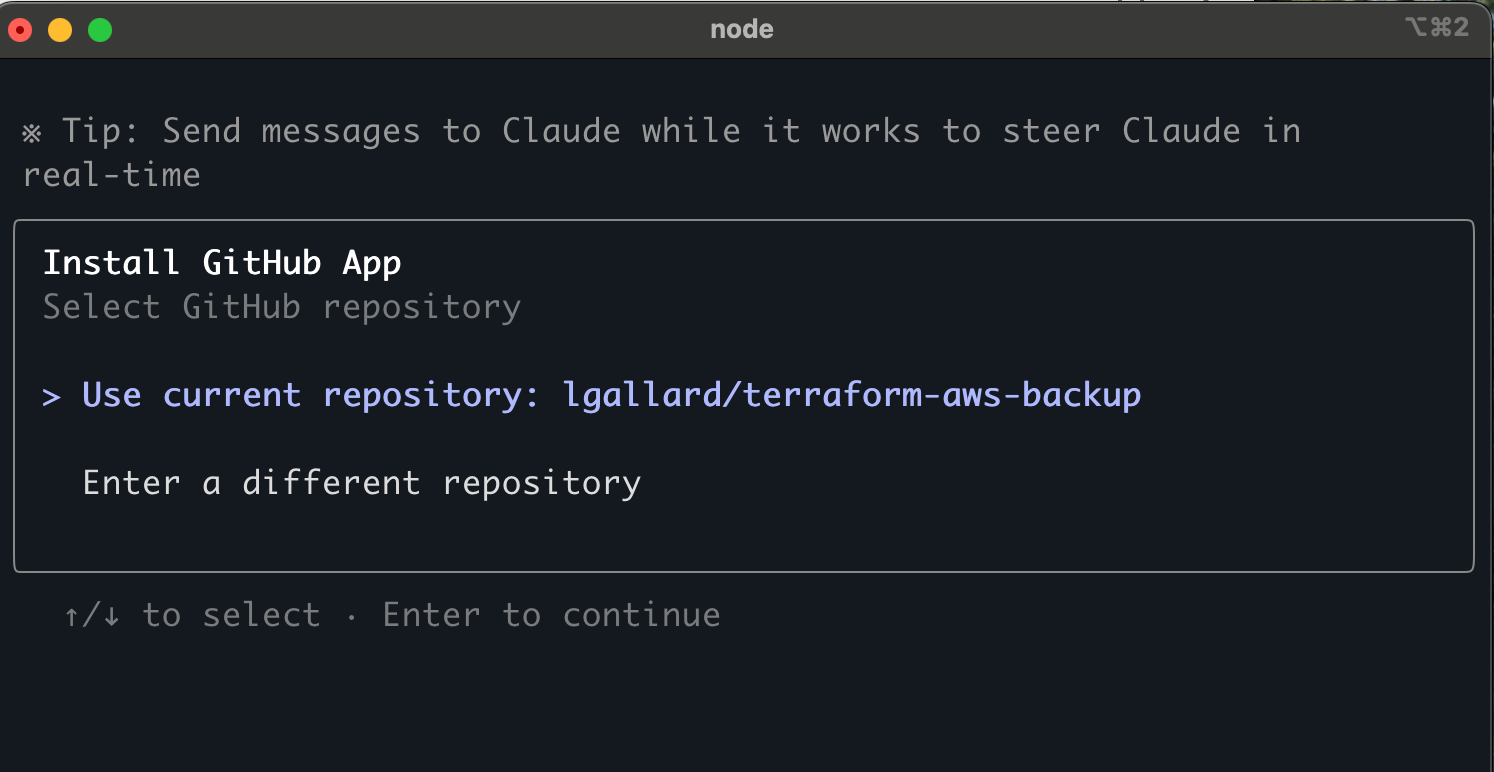
You can use your current repository or specify a different one. This step ensures Claude Code gets the appropriate permissions for your specific project.
Step 3: Configure API Authentication
Next, you’ll need to set up your API authentication method:
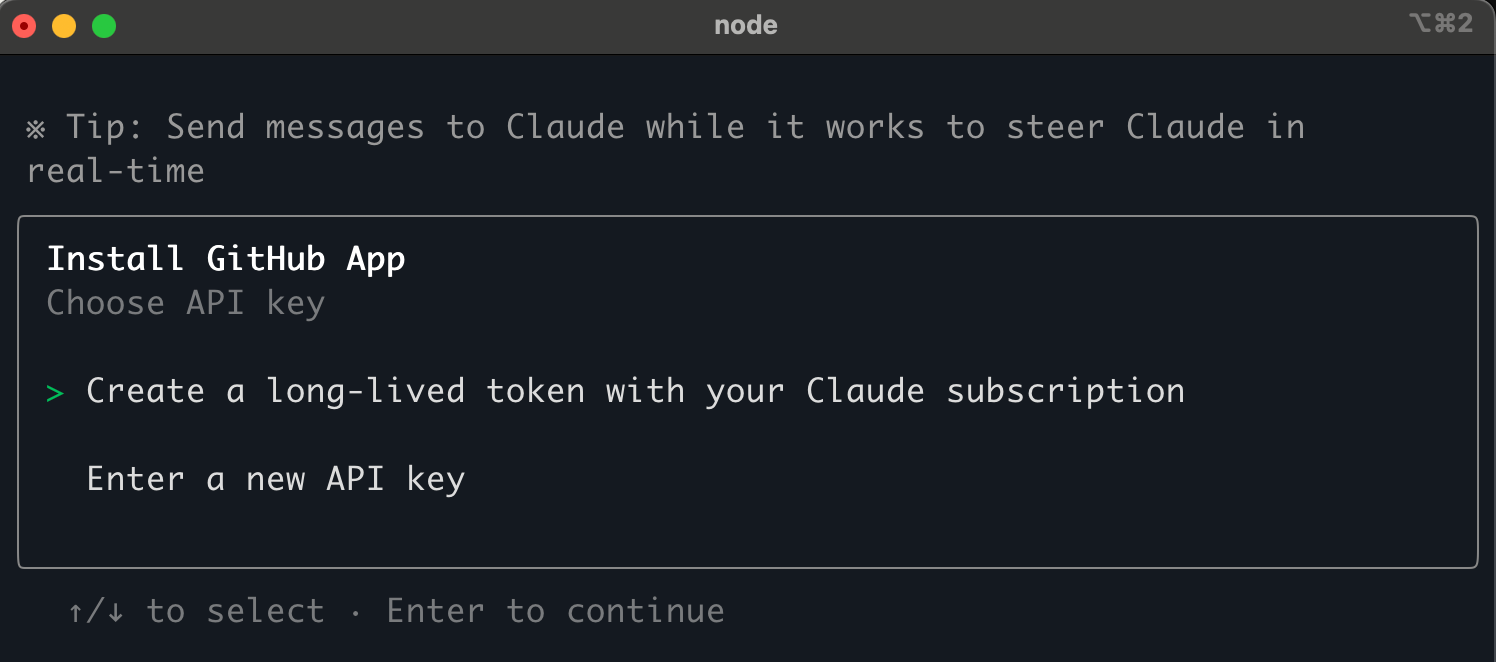
Choose between:
- Create a long-term token with your Claude subscription (recommended for personal projects)
- Enter a new API key (for custom enterprise setups)
Step 4: Complete GitHub App Installation
The installer will open your browser to complete the GitHub App installation:
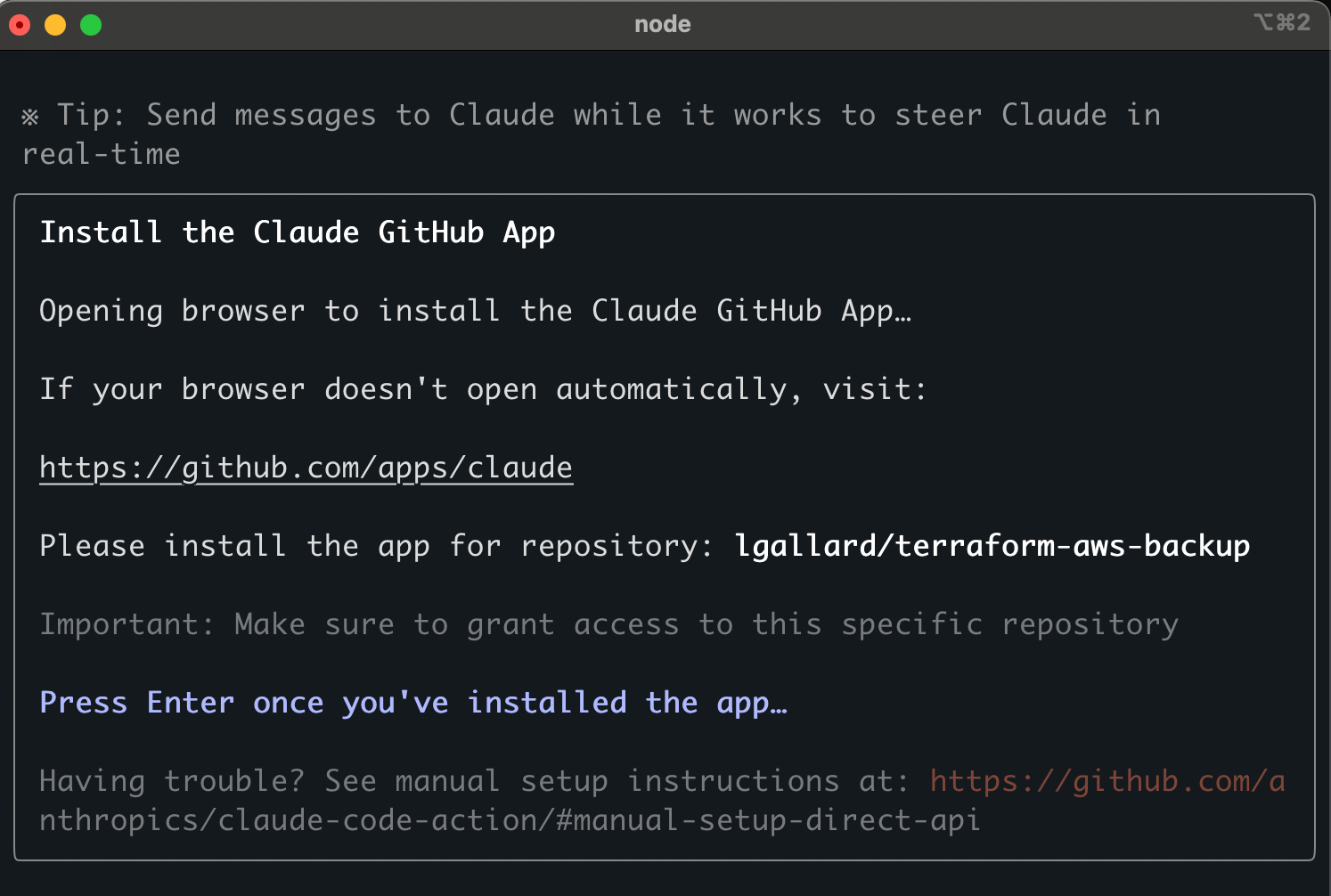
This redirects you to GitHub’s app installation page where you’ll grant the necessary permissions.
Step 5: Organization Selection
If you’re part of multiple organizations, select the appropriate one:
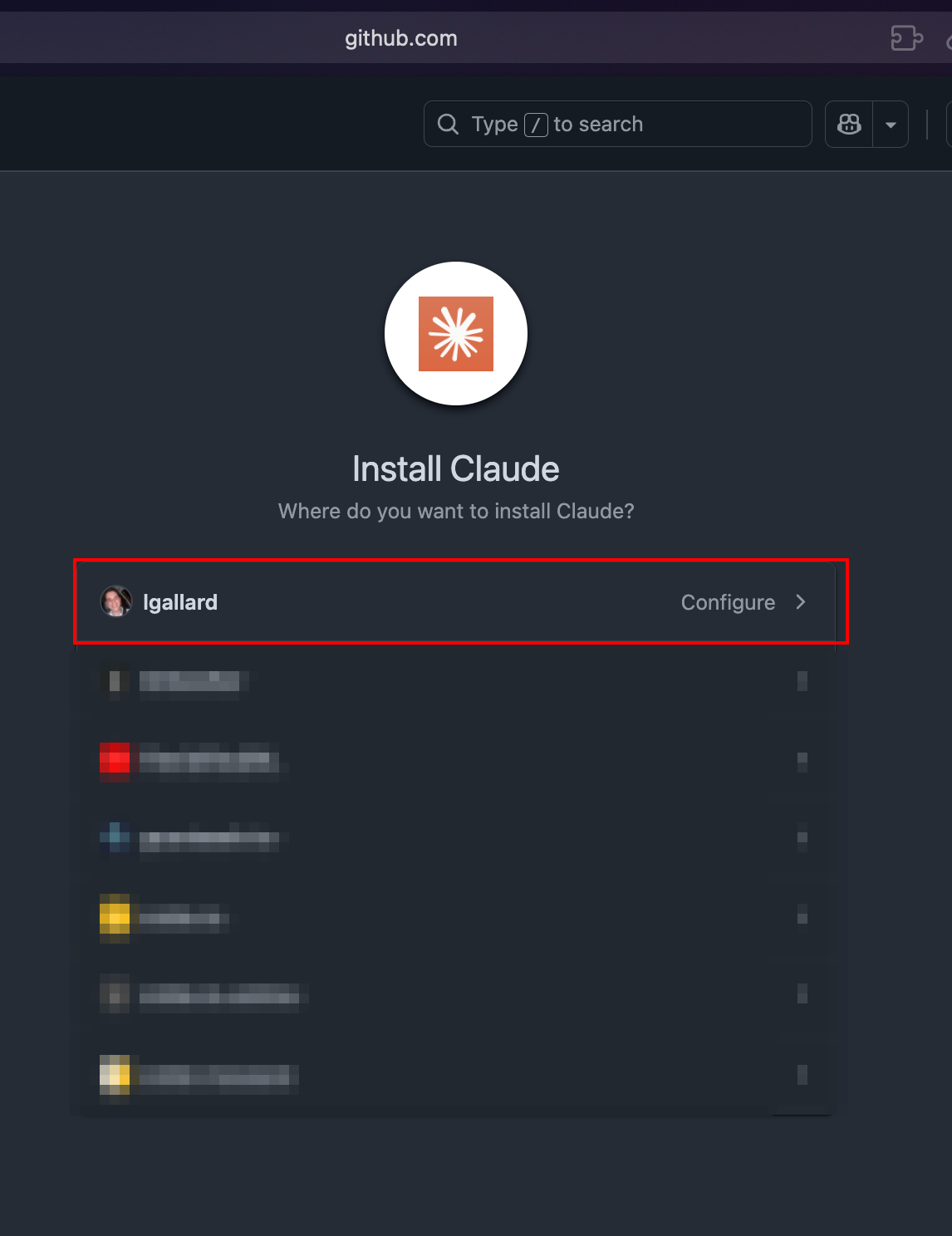
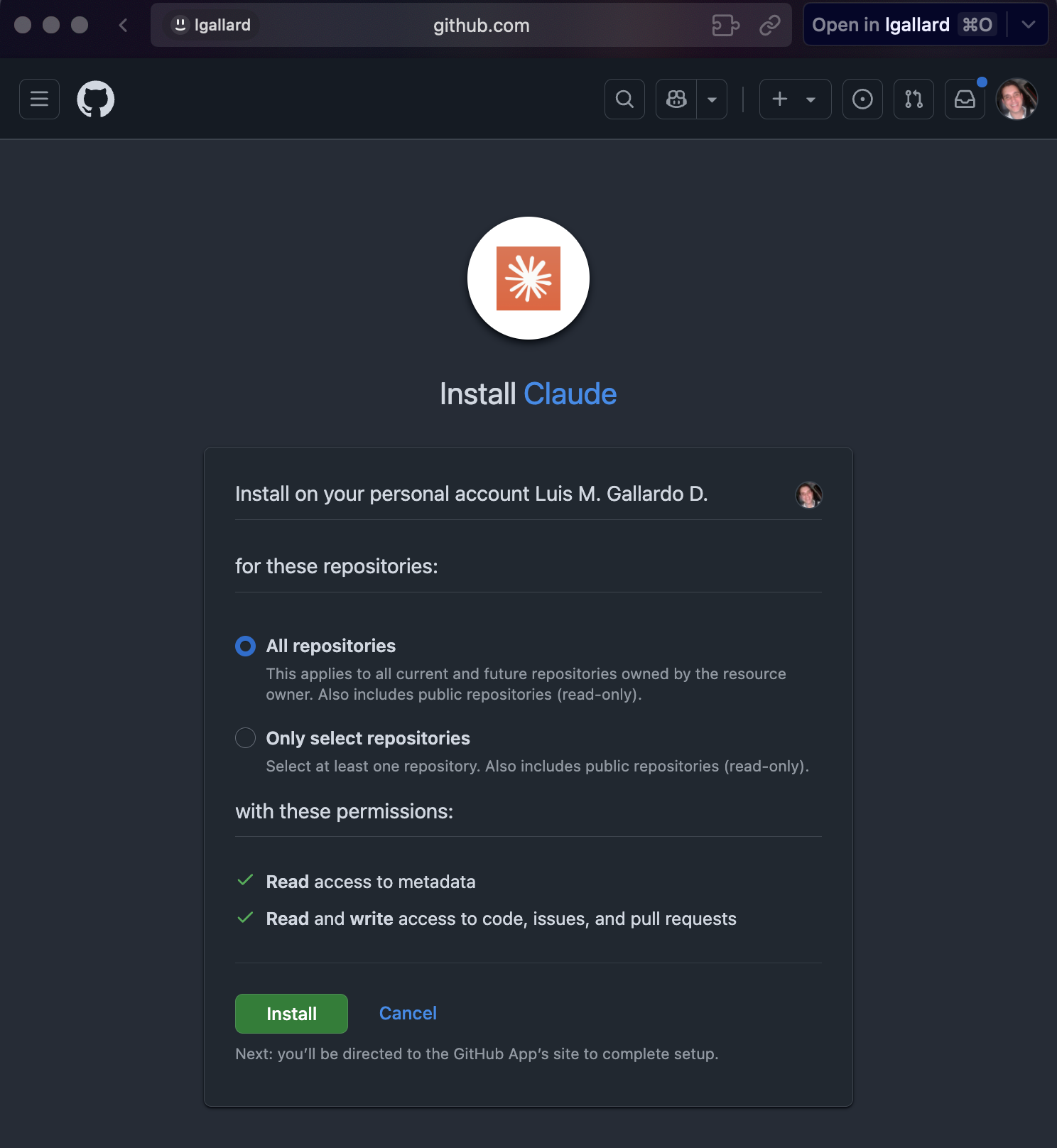
Choose your personal account or the organization that owns the repository you want to configure.
Step 6: Install Claude GitHub App
Complete the Claude GitHub App installation:
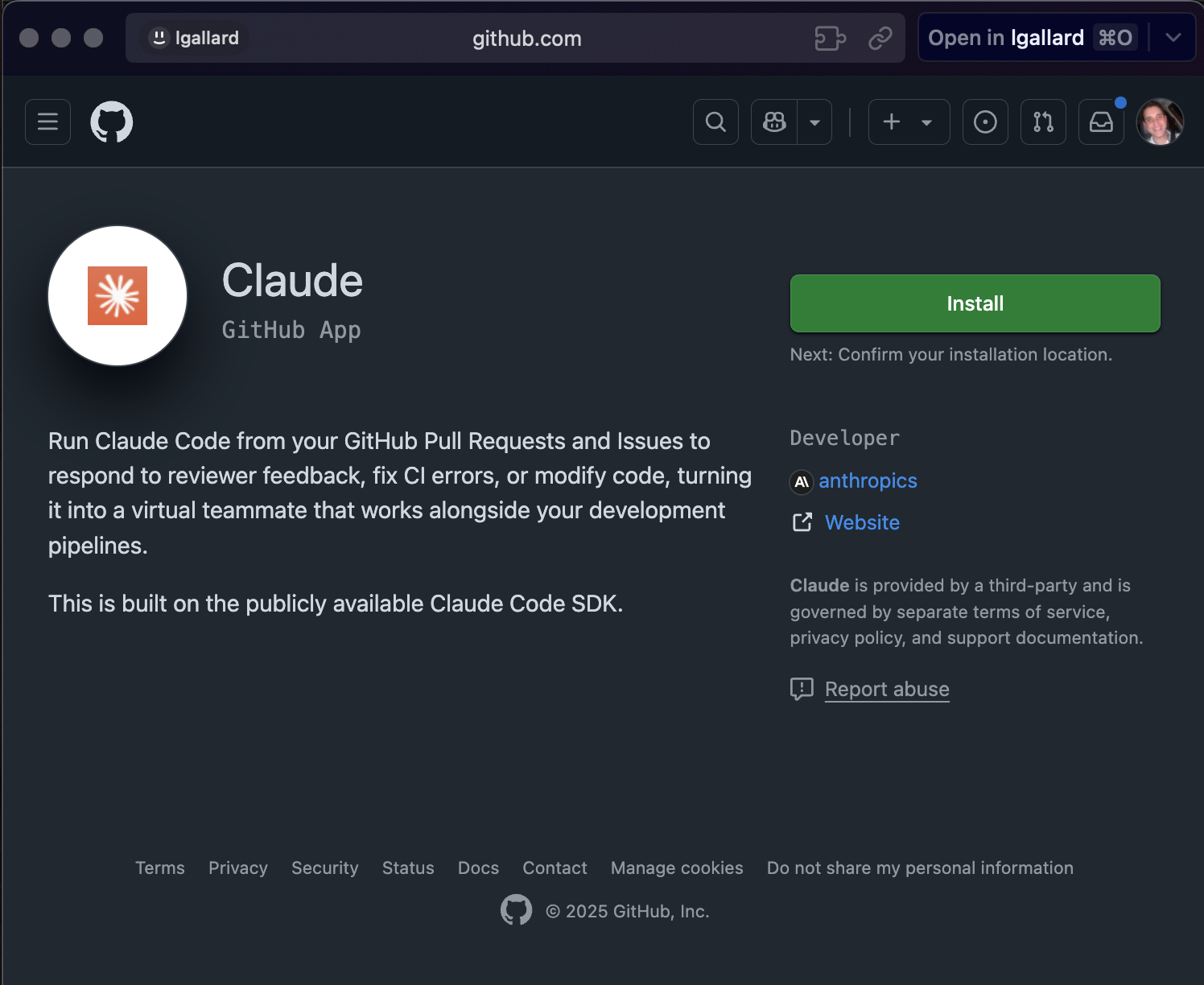
Review and confirm the permissions. The Claude GitHub App needs:
- Read access to metadata
- Read and write access to code, issues, and pull requests
Step 7: Final Authentication
Complete the authentication process:
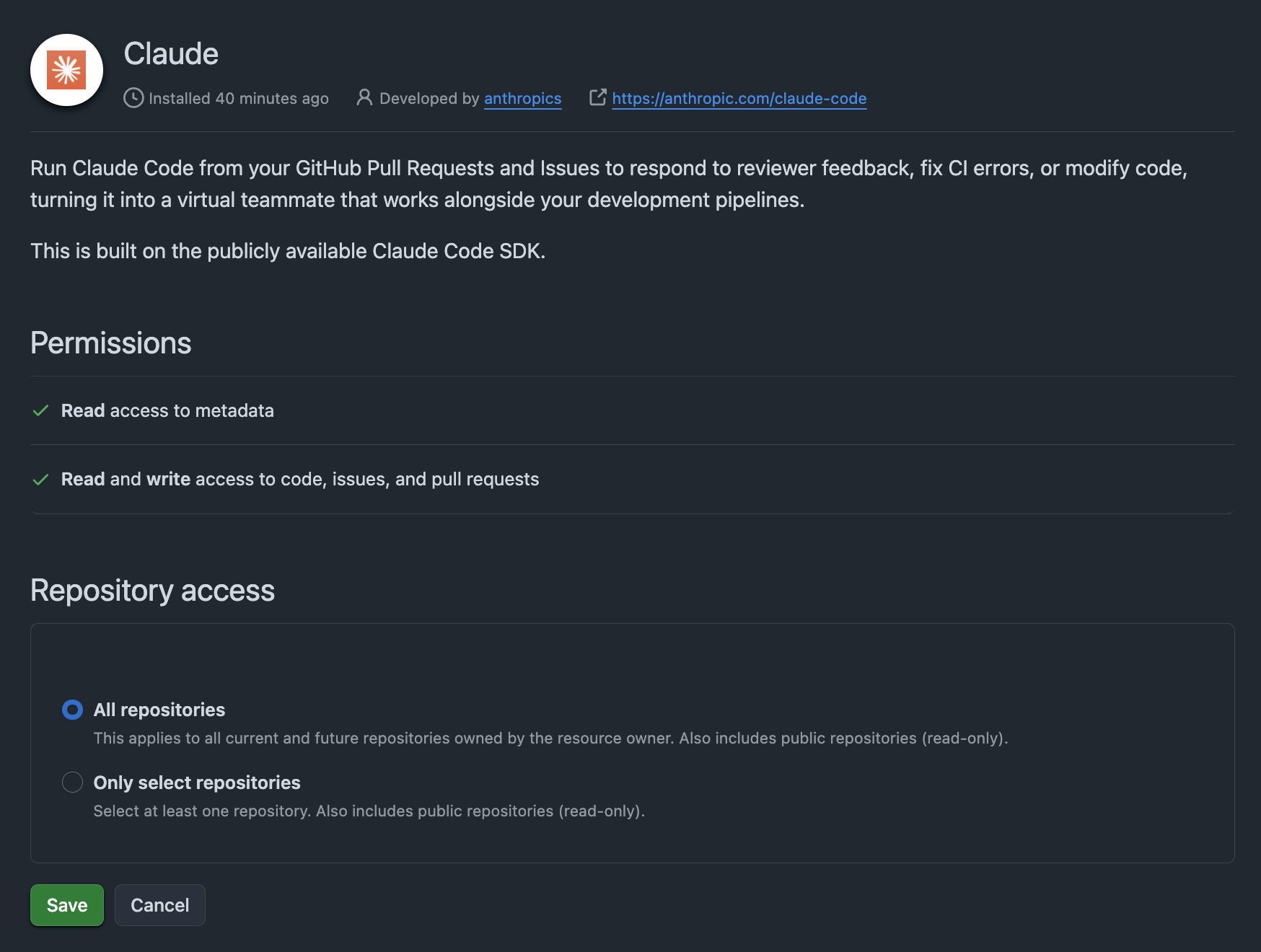
Once authentication is complete, Claude Code will automatically:
- Install the GitHub App to your repository
- Add your API key as a repository secret (
ANTHROPIC_API_KEY) - Create the workflow file at
.github/workflows/claude.yml
Step 8: Select GitHub Workflows
During the installation process, you’ll be prompted to select which workflows to install:
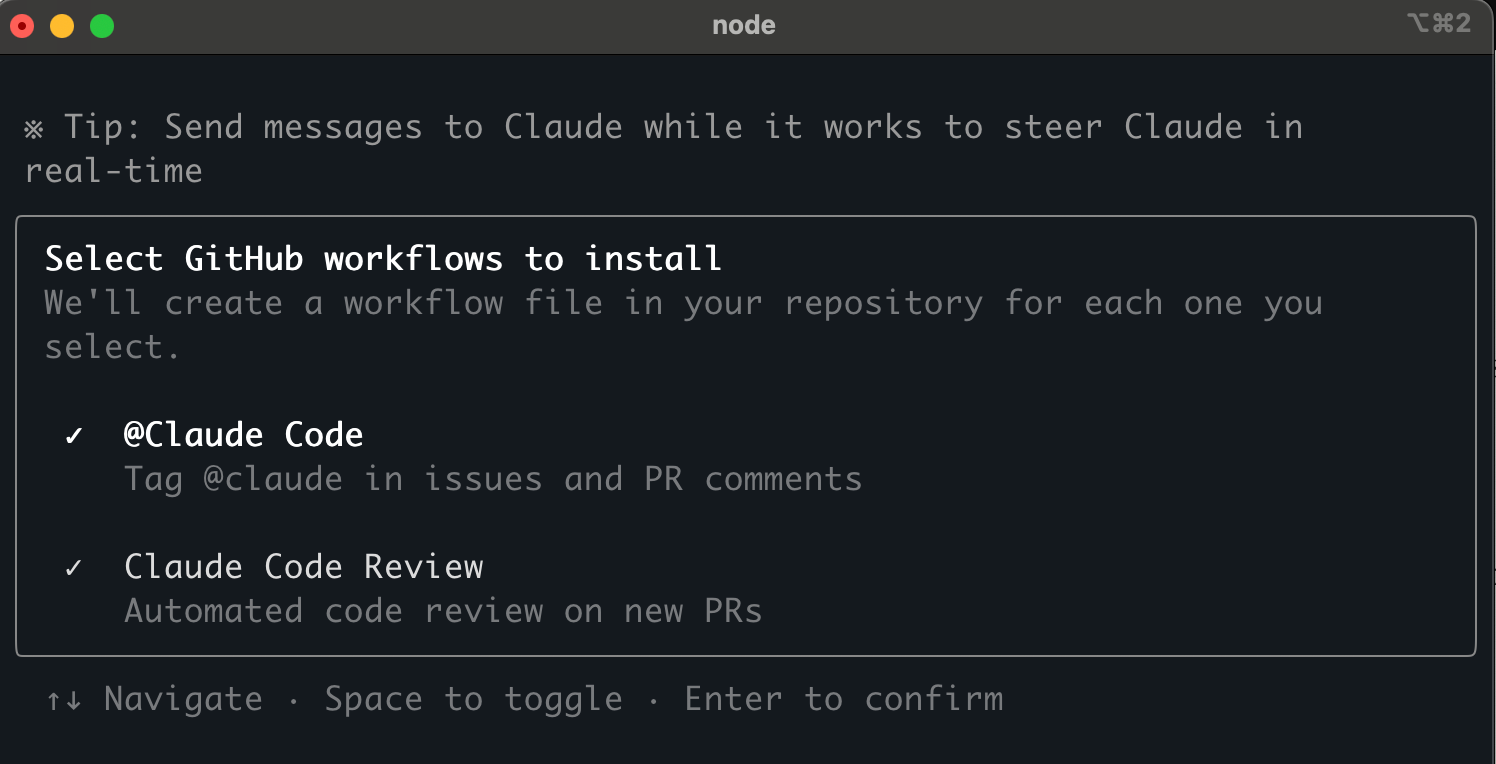
You can choose between:
- @Claude Code: Interactive workflow triggered by
@claudementions in issues and PR comments - Claude Code Review: Automated review workflow that runs on new pull requests
Both options provide different approaches to integrating Claude into your development workflow.
Step 9: Review the Automated Pull Request
Claude Code automatically creates a pull request with the necessary workflow files:
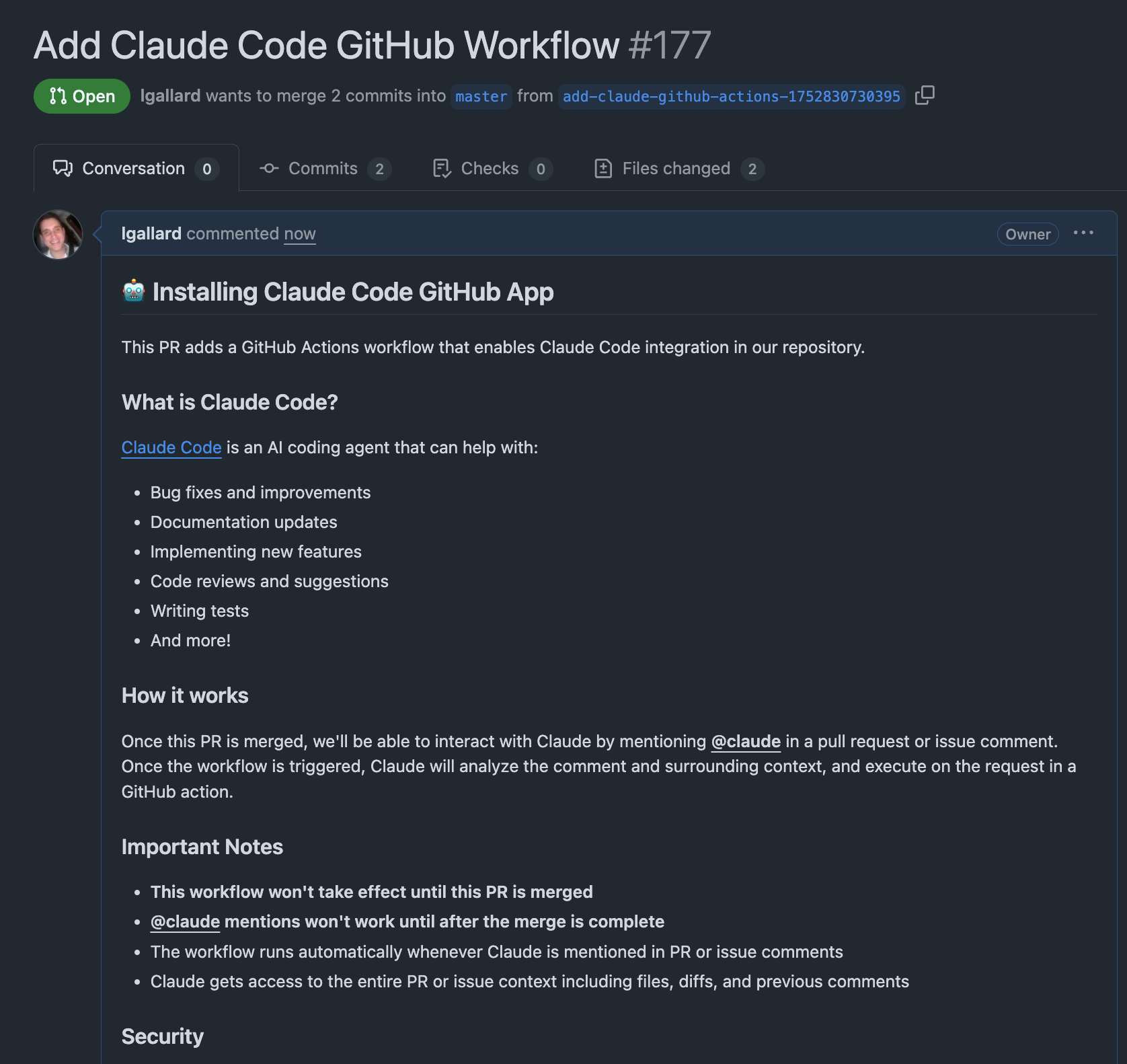
The PR includes comprehensive documentation explaining what Claude Code can do and how to use it effectively.
Step 10: Claude Reviews Its Own Work
One of the most impressive features is that Claude can review its own pull request, providing detailed analysis:
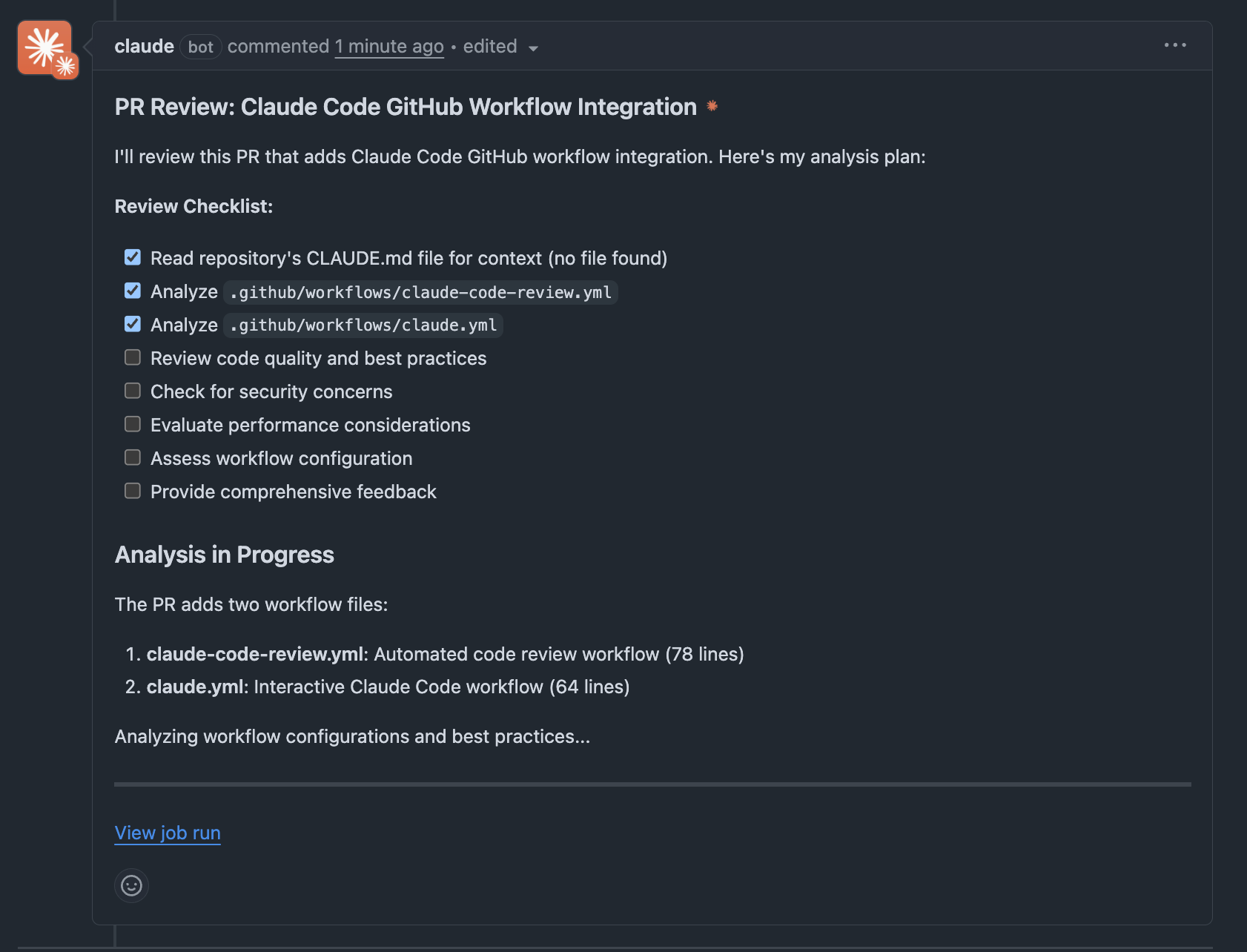
Claude automatically analyzes the workflow files and provides a comprehensive assessment:
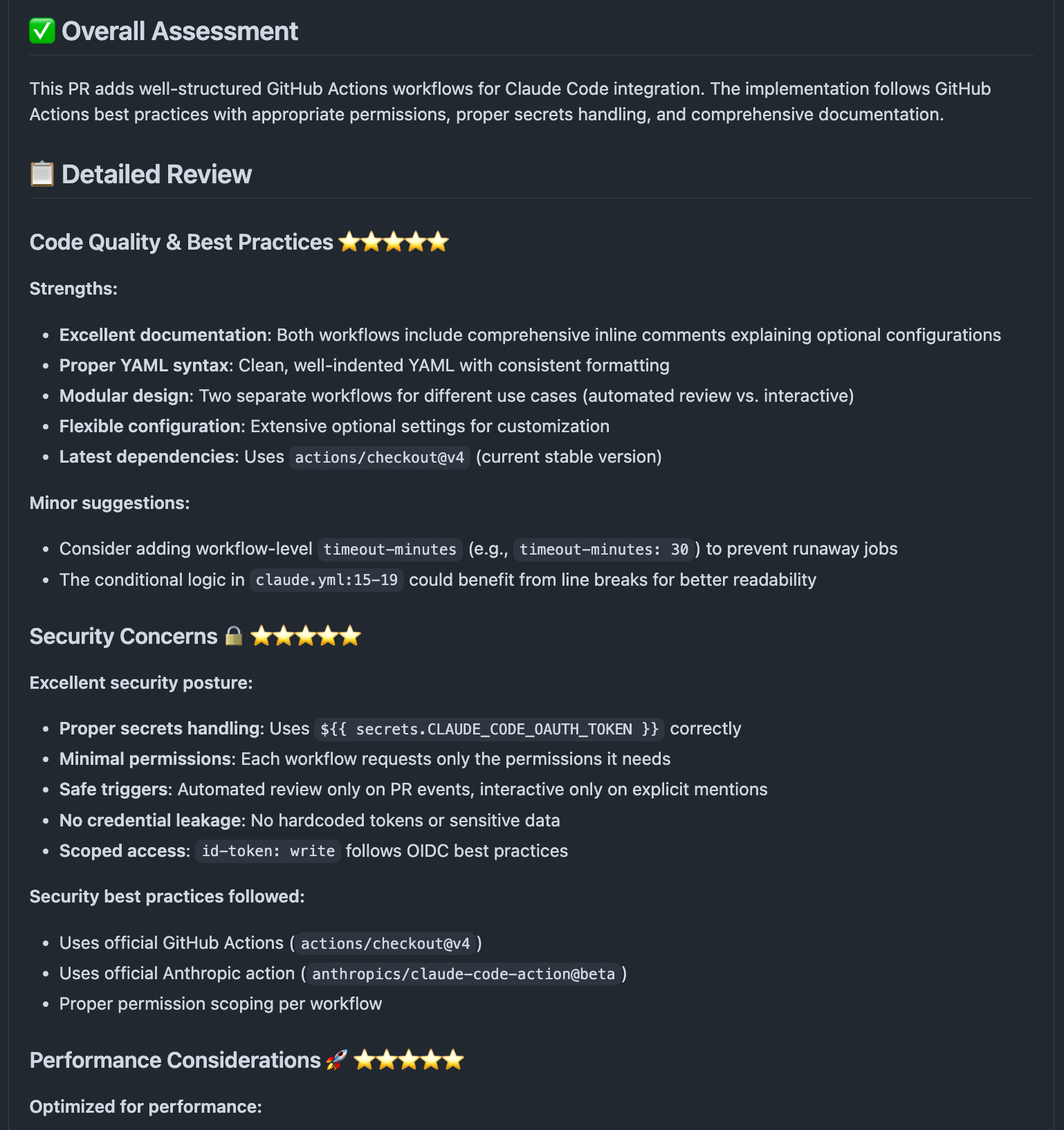
The review includes detailed feedback on code quality, security practices, and performance considerations:
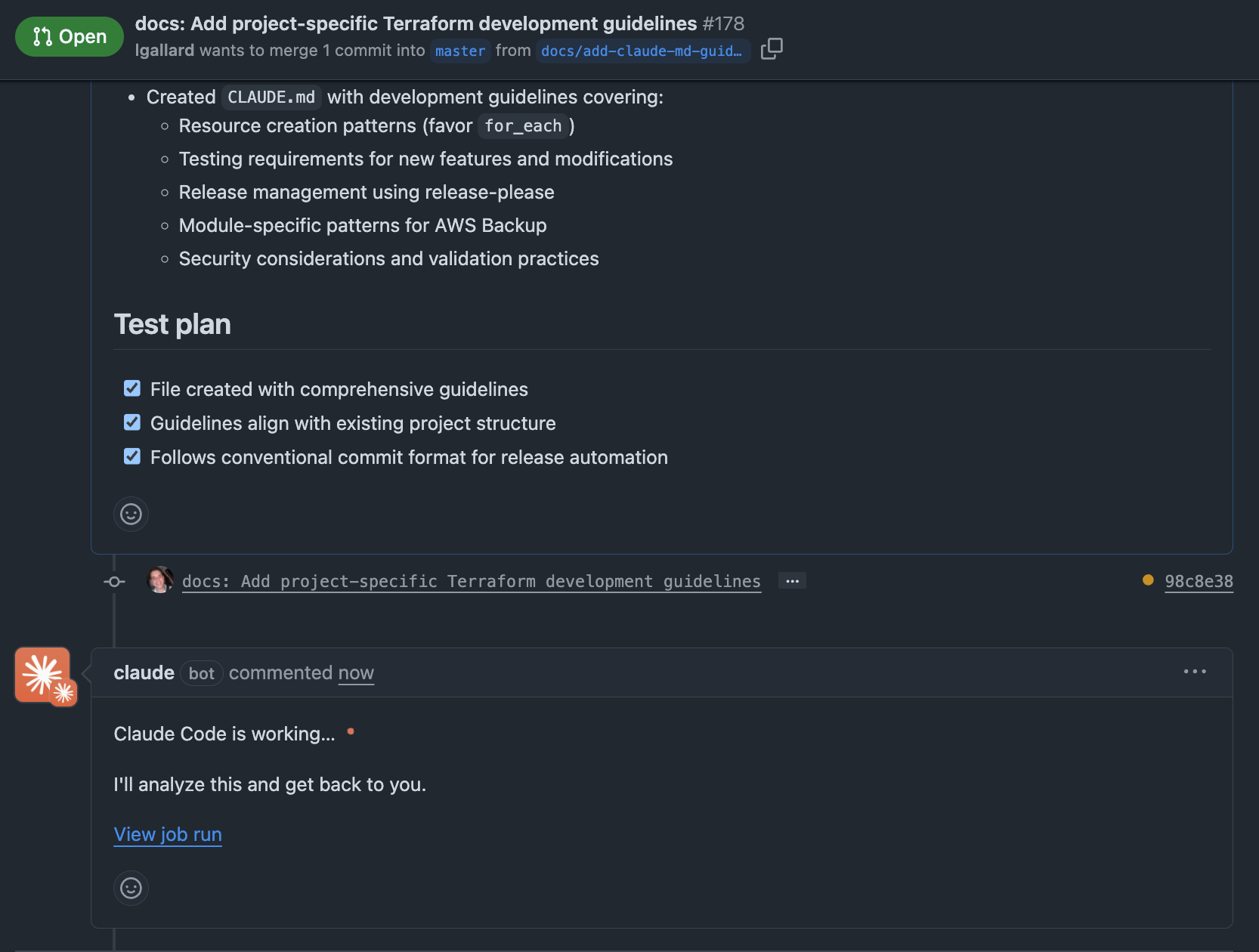
Upon completion, Claude provides a comprehensive review summary with detailed analysis:
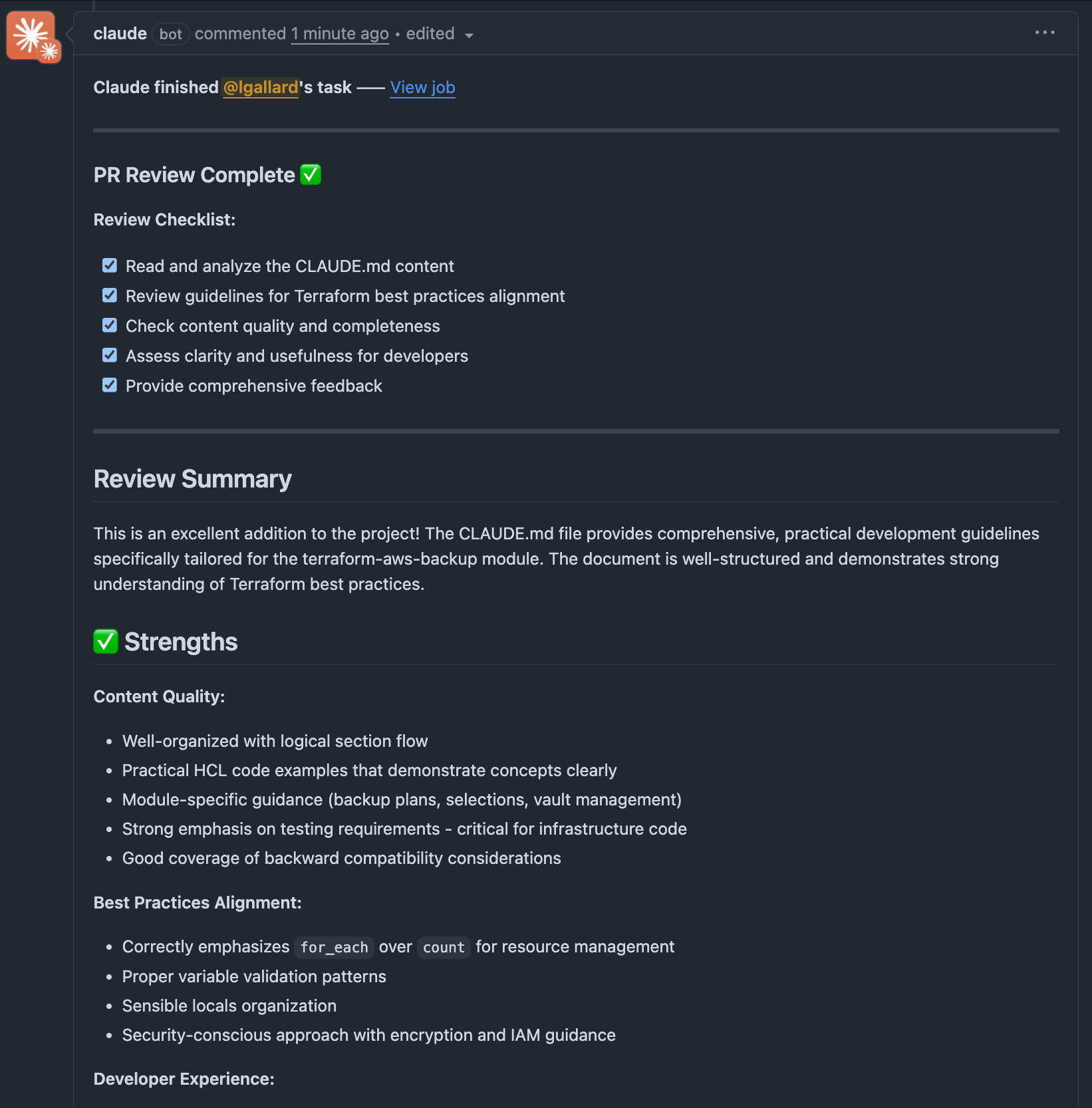
This shows Claude’s thorough evaluation including code quality assessment, security analysis, and developer experience considerations.
Step 11: Complete Authentication Setup
After reviewing the PR, complete the final authentication step:

Step 12: Installation Complete
Once everything is set up, you’ll see a success confirmation:
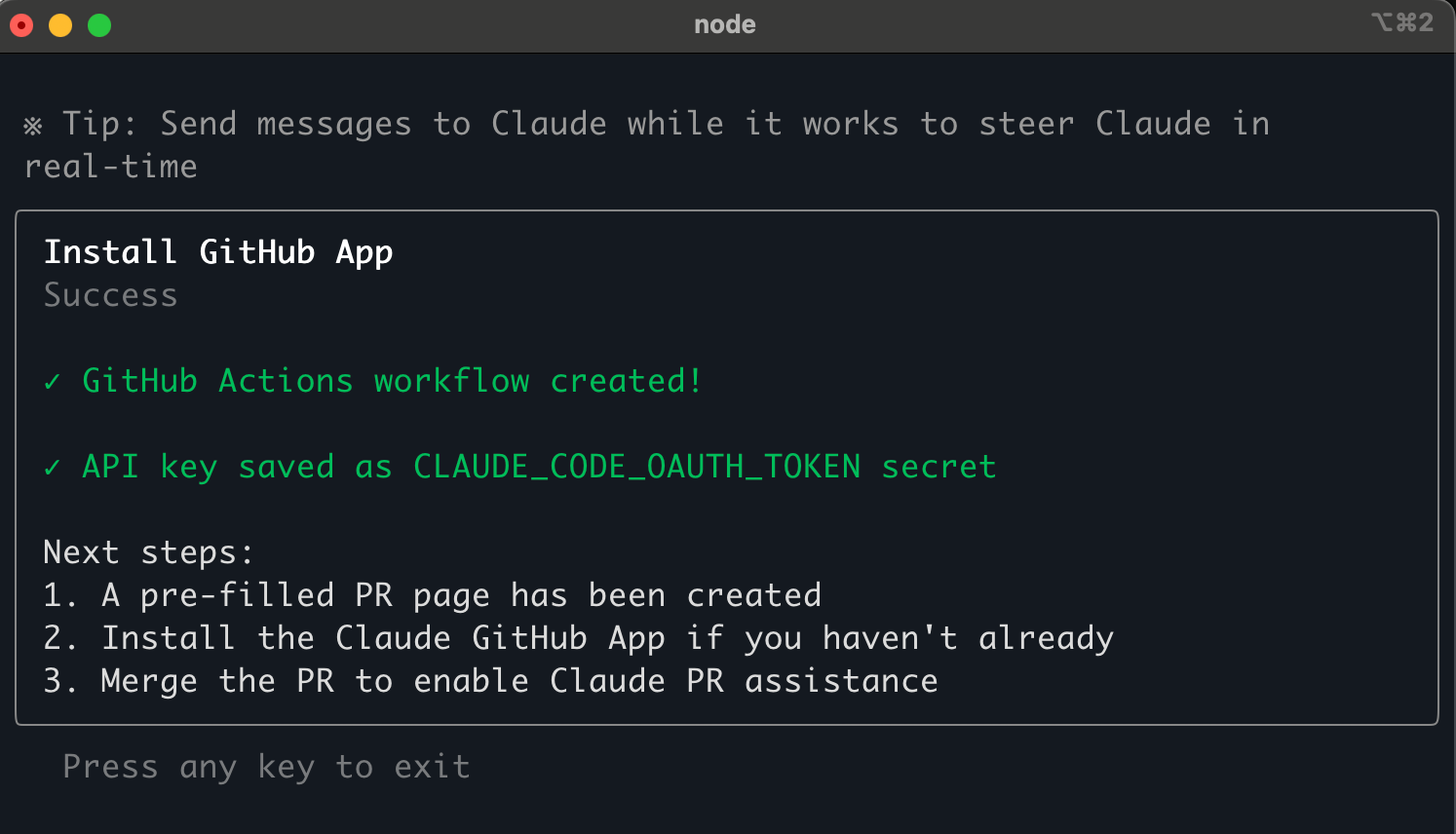
The installation process provides clear next steps:
- Merge the PR to enable Claude Code functionality
- Install the Claude GitHub App if not already done
- Start using
@claudementions in your issues and PRs
🔧 Manual Setup (Alternative Method)
If the quick setup doesn’t work or you prefer manual configuration, follow these steps:
1. Install Claude GitHub App
Visit https://github.com/apps/claude and install the app to your repository.
2. Add Repository Secrets
Navigate to your repository’s Settings → Secrets and variables → Actions and add:
ANTHROPIC_API_KEY: your_anthropic_api_key_here
3. Create Workflow File
Create .github/workflows/claude.yml with this configuration:
name: Claude Code
on:
issue_comment:
types: [created]
pull_request_review_comment:
types: [created]
issues:
types: [opened, assigned]
pull_request_review:
types: [submitted]
jobs:
claude:
if: |
(github.event_name == 'issue_comment' && contains(github.event.comment.body, '@claude')) ||
(github.event_name == 'pull_request_review_comment' && contains(github.event.comment.body, '@claude')) ||
(github.event_name == 'pull_request_review' && contains(github.event.review.body, '@claude')) ||
(github.event_name == 'issues' && (contains(github.event.issue.body, '@claude') || contains(github.event.issue.title, '@claude')))
runs-on: ubuntu-latest
permissions:
contents: write
pull-requests: write
issues: write
id-token: write
steps:
- name: Checkout repository
uses: actions/checkout@v4
with:
fetch-depth: 1
- name: Run Claude Code
uses: anthropics/claude-code-action@beta
with:
anthropic_api_key: $
allowed_tools: 'mcp__github__create_pull_request'
🏢 Enterprise Setup (AWS Bedrock & Google Vertex AI)
For enterprise environments, you can configure Claude Code to use your existing cloud infrastructure:
AWS Bedrock Configuration
name: Claude PR Action (AWS Bedrock)
permissions:
contents: write
pull-requests: write
issues: write
id-token: write
on:
issue_comment:
types: [created]
pull_request_review_comment:
types: [created]
issues:
types: [opened, assigned]
jobs:
claude-pr:
if: contains(github.event.comment.body, '@claude') || contains(github.event.issue.body, '@claude')
runs-on: ubuntu-latest
env:
AWS_REGION: us-west-2
steps:
- name: Checkout repository
uses: actions/checkout@v4
- name: Configure AWS Credentials (OIDC)
uses: aws-actions/configure-aws-credentials@v4
with:
role-to-assume: $
aws-region: us-west-2
- uses: anthropics/claude-code-action@beta
with:
trigger_phrase: "@claude"
timeout_minutes: "60"
use_bedrock: "true"
model: "us.anthropic.claude-3-7-sonnet-20250219-v1:0"
Google Vertex AI Configuration
name: Claude PR Action (Vertex AI)
permissions:
contents: write
pull-requests: write
issues: write
id-token: write
on:
issue_comment:
types: [created]
pull_request_review_comment:
types: [created]
issues:
types: [opened, assigned]
jobs:
claude-pr:
if: contains(github.event.comment.body, '@claude') || contains(github.event.issue.body, '@claude')
runs-on: ubuntu-latest
steps:
- name: Checkout repository
uses: actions/checkout@v4
- name: Authenticate to Google Cloud
uses: google-github-actions/auth@v2
with:
workload_identity_provider: $
service_account: $
- uses: anthropics/claude-code-action@beta
with:
trigger_phrase: "@claude"
timeout_minutes: "60"
use_vertex: "true"
model: "claude-3-7-sonnet@20250219"
env:
ANTHROPIC_VERTEX_PROJECT_ID: $
CLOUD_ML_REGION: us-east5
📝 Configuration Best Practices
Create a CLAUDE.md File
Create a CLAUDE.md file in your repository root to guide Claude’s behavior:
# Project Guidelines for Claude Code
## Code Style
- Use TypeScript for all new code
- Follow ESLint configuration
- Prefer functional components in React
- Use async/await over Promises
## Review Criteria
- Ensure all functions have proper error handling
- Check for type safety (no `any` types)
- Verify performance implications
- Validate accessibility requirements
## Project Structure
- `/src` - Main application code
- `/tests` - Test files
- `/docs` - Documentation
- `/scripts` - Build and deployment scripts
## Testing Requirements
- Unit tests for all business logic
- Integration tests for API endpoints
- E2E tests for critical user flows
Security Considerations
- ✅ Never commit API keys to your repository
- ✅ Use GitHub Secrets for all sensitive configuration
- ✅ Limit permissions to only what’s necessary
- ✅ Review Claude’s suggestions before merging
- ✅ Set appropriate timeouts to prevent runaway workflows
🎯 Comprehensive Usage Examples
Now that Claude Code is installed, here are practical examples of how to leverage its capabilities in your daily development workflow:
🔧 Feature Implementation
Turn Issues into Pull Requests
Create an issue with a feature description, then comment:
@claude implement this feature based on the issue description
Claude will:
- Analyze the issue requirements
- Review your existing code patterns
- Write the implementation following your coding standards
- Create tests if specified in your
CLAUDE.md - Open a pull request with the complete feature
Example: “Add user avatar upload functionality with S3 integration”
🐛 Bug Fixing
Automatic Bug Resolution
When you encounter a bug, create an issue or comment:
@claude fix the TypeError in the user dashboard component
Claude will:
- Locate the problematic code
- Analyze the root cause
- Implement an appropriate fix
- Add error handling when appropriate
- Create a PR with the solution
Advanced Bug Fixing:
@claude fix the memory leak in the WebSocket connection manager.
The issue occurs when users rapidly switch between channels.
💡 Implementation Guidance
Get Architecture Advice
In a PR comment:
@claude how should I implement user authentication for this endpoint?
Claude provides:
- Security best practices
- Code examples specific to your stack
- Integration patterns with your existing auth system
- Performance considerations
Complex Implementation Help:
@claude help me implement a rate limiting system for this API.
I need to support different limits per user tier and graceful degradation.
📋 Code Review and Quality Assurance
Comprehensive Code Reviews
@claude review this PR for security vulnerabilities and performance issues
Claude performs:
- Security vulnerability scanning
- Performance bottleneck identification
- Code quality assessment
- Best practices validation
- Accessibility compliance checks
Specific Review Focus:
@claude review this database migration for potential data loss and rollback safety
🧪 Testing and Documentation
Test Generation
@claude write comprehensive tests for this new payment processing module
Claude creates:
- Unit tests for all functions
- Integration tests for external APIs
- Edge case testing
- Mock implementations for dependencies
Documentation Updates
@claude update the API documentation to reflect these new endpoints
README Improvements:
@claude enhance the project README with better setup instructions and examples
🏗️ Refactoring and Optimization
Code Modernization
@claude refactor this component to use React hooks instead of class components
Performance Optimization:
@claude optimize this database query - it's causing timeouts on large datasets
Legacy Code Updates:
@claude update this Node.js 14 code to Node.js 20,
including dependency updates and deprecated API replacements
🔒 Security Improvements
Security Audits
@claude audit this authentication flow for security vulnerabilities
Dependency Security:
@claude check our package.json dependencies for security issues
and suggest safer alternatives
🚀 DevOps and Deployment
CI/CD Improvements
@claude optimize our GitHub Actions workflow to reduce build times
Docker Optimization:
@claude improve this Dockerfile for better caching and smaller image size
Infrastructure as Code:
@claude review this Terraform configuration for AWS security best practices
📊 Advanced Workflows
Multi-Step Feature Development
@claude implement a complete user notification system:
1. Database schema for notifications
2. API endpoints for CRUD operations
3. WebSocket integration for real-time updates
4. Email notification worker
5. Frontend notification component
6. Comprehensive test suite
Migration Assistance:
@claude help migrate our REST API to GraphQL:
- Create schema definitions
- Implement resolvers
- Update frontend queries
- Maintain backward compatibility
🎨 Frontend Development
Component Creation
@claude create a reusable data table component with:
- Sorting and filtering
- Pagination
- Row selection
- Export functionality
- Responsive design
Styling and UX:
@claude improve the accessibility of this form component
and add proper ARIA labels
📈 Analytics and Monitoring
Observability Implementation
@claude add comprehensive logging and monitoring to this service:
- Structured logging with correlation IDs
- Metrics collection for key business events
- Error tracking and alerting
- Performance monitoring
Data Analysis:
@claude analyze our user engagement metrics and suggest A/B testing scenarios
💡 Pro Tips for Effective Claude Usage
- Be Specific: The more context you provide, the better Claude’s suggestions will be
- Reference Files: Use
@filenameto help Claude understand your codebase - Set Expectations: Mention your preferred patterns in
CLAUDE.md - Iterative Feedback: Engage in conversation to refine the implementation
- Review Carefully: Always review Claude’s suggestions before merging
These examples demonstrate Claude Code’s versatility in handling everything from simple bug fixes to complex architectural decisions. The key is treating Claude as a knowledgeable team member who can understand context and follow your project’s established patterns.
💰 Cost Considerations
When using Claude Code GitHub Actions, be aware of the associated costs:
GitHub Actions Costs
- Runs on GitHub-hosted runners
- Consumes your GitHub Actions minutes
- See GitHub’s billing documentation
API Costs
- Each Claude interaction consumes tokens based on prompt/response length
- Usage varies by task complexity and codebase size
- See Claude’s pricing page for current rates
Cost Optimization Tips
- Use specific
@claudecommands to reduce unnecessary API calls - Set appropriate
max_turnslimits - Establish reasonable
timeout_minutesto prevent runaway workflows - Consider using GitHub’s concurrency controls to limit parallel executions
🔍 Troubleshooting
Claude Doesn’t Respond
- ✅ Verify GitHub App is installed correctly
- ✅ Check that workflows are enabled in your repository
- ✅ Ensure API key is set in repository secrets
- ✅ Confirm comment contains
@claude(not/claude)
Authentication Errors
- ✅ Confirm API key is valid and has sufficient permissions
- ✅ For Bedrock/Vertex, verify cloud credential configuration
- ✅ Ensure secrets are named correctly in workflows
Workflow Doesn’t Trigger
- ✅ Verify workflow triggers include necessary events
- ✅ Check that app permissions include CI triggers
- ✅ Ensure you’re using the GitHub App (not Actions user)
🎉 Conclusion
Claude Code GitHub Actions represents a significant step forward in AI-assisted development workflows. By automating code reviews, feature implementation, and bug fixes, teams can focus on high-level architecture and business logic while maintaining high code quality standards.
The setup process is straightforward—whether you choose the quick installation method or opt for enterprise cloud provider integration. With proper configuration and the right CLAUDE.md guidelines, Claude becomes a valuable team member that works around the clock to improve your codebase.
Start with simple use cases like automated code reviews, then gradually expand to more complex workflows as your team becomes comfortable with AI-assisted development. The future of collaborative coding is here, and it’s more accessible than ever! 🚀
Pro Tip: Consider using Claude Code locally first to understand its capabilities before deploying it to your CI/CD pipeline. This helps you create better prompts and set up more effective automation rules.



